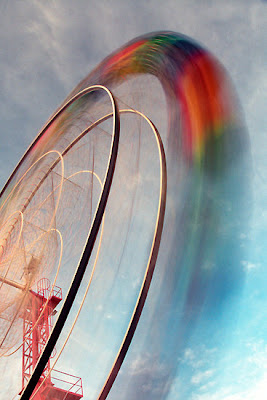

H O P P E R P E D I A ©
-Brian Hammons
June 14, 2010: 5,370 hits

Motion blur is frequently used to show a sense of speed. You can artificially achieve this effect using a camera with a slow shutter speed. As objects in a scene move, each image in the scene will be captured at each point of it's movement and represent the correlated positions of those objects, as well as the camera's viewpoint, over the period of exposure determined by the shutter speed. In such an image, any object moving with respect to the camera will look blurred or smeared along the direction of relative motion. This smearing may occur on an object that is moving or on a static background if the camera is moving. In a film or television image, this looks natural because the human eye behaves in much the same way.
Because the effect is caused by the relative motion between the camera, and the objects and scene, motion blur may be avoided by panning the camera to track those moving objects. In this case, even with long exposure times, the objects will appear sharper, and the background more blurred.
Tips for capturing movement:
Slow Down Your Shutter Speed
The reason for movement blur is simply that the amount of time that the shutter of a camera is open long enough to allow your camera’s image sensor to ’see’ the movement of your subject.
So the number one tip in capturing movement in an image is to select a longer shutter speed.
If your shutter speed is fast (eg 1/4000th of a second) it’s not going to see much movement (unless the the subject is moving extremely fast). If you select a longer shutter speed (eg 5 seconds) you don’t need your subject to move very much at all before you start to see blur.
Computer animation: "Slightly off subject, but worthy"
In computer animation, animators will "cinematize" objects to make them look natural and smooth. Without this simulated effect each frame shows a perfect instant in time (analogous to a camera with an infinitely fast shutter), with zero motion blur. This is why a video game with a frame rate of 25-30 frames per second will seem staggered, while natural motion filmed at the same frame rate appears continuous. Many next generation video games feature motion blur, especially vehicle simulation games. In pre-rendered computer animation, such as CGI movies, realistic motion blur can be drawn because the renderer has more time to draw each frame. Temporal anti-aliasing reduces the effects of insufficient sampling. In effect, the exposure time of the device allows it to take many more samples and combine these optically to reduce the temporal resolution and hence reduce the information storage requirements.